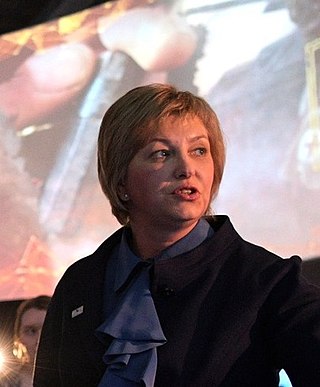
Brookwood Cemetery, also known as the London Necropolis, is a burial ground in Brookwood, Surrey, England. It is the largest cemetery in the United Kingdom and one of the largest in Europe. The cemetery is listed a Grade I site in the Register of Historic Parks and Gardens.

Khimki is a city in Moscow Oblast, Russia. It is located approximately 18 kilometres (11 mi) northwest from central Moscow, and is part of the Moscow metropolitan area.

The 26 Baku Commissars Memorial was a Soviet-era monument located in Baku, Azerbaijan, that paid tribute to the 26 Baku Commissars from the Baku commune. The commune was overthrown in 1918 and the commissars were later executed near Krasnovodsk. The monument was constructed by sculptors I. Zeynalov and N. Mamedov, and architects G. Aleskerov and Alesker Huseynov, who eventually became prominent politicians in Azerbaijan. The remains of the Commissars were buried at the site of the memorial.

FC Khimki is a Russian professional football club based in Khimki. It returned to the Russian Premier League for the 2024–25 season.

In Chechnya, mass graves containing hundreds of corpses have been uncovered since the beginning of the Chechen wars in 1994. As of June 2008, there were 57 registered locations of mass graves in Chechnya. According to Amnesty International, thousands may be buried in unmarked graves including up to 5,000 civilians who disappeared since the beginning of the Second Chechen War in 1999. In 2008, the largest mass grave found to date was uncovered in Grozny, containing some 800 bodies from the First Chechen War in 1995. Russia's general policy to the Chechen mass graves is to not exhume them.

The 26 Baku Commissars were Bolshevik and Left Socialist Revolutionary (SR) members of the Baku Commune. The commune was established in the city of Baku, which was then the capital of the briefly independent Azerbaijan Democratic Republic, and is now the capital of the Republic of Azerbaijan. The commune, led by Stepan Shahumyan, existed until 26 July 1918 when the Bolsheviks were forced out of power by a coalition of Dashnaks, Right SRs and Mensheviks.

Sergei Nikolayevich Yuran is a Ukrainian-born Russian professional football manager and a former player.
Novye Khimki Stadium is football stadium in Khimki, Russia. It is the home ground of youth teams of FC Khimki, although it is sometimes used by senior team. The stadium holds 3,066 people. The football pitch was constructed in 1999, and the stands were built in 2006.

Yerablur or Yerablur Military Pantheon is a military cemetery located on a hilltop in the outskirts of Yerevan, Armenia. Since 1988, Yerablur has become the burial place of Armenian soldiers who died during the Nagorno-Karabakh conflict.

The Bronze Soldier is the informal name of a controversial Soviet World War II war memorial in Tallinn, Estonia, built at the site of several war graves, which were relocated to the nearby Tallinn Military Cemetery in 2007. It was originally named "Monument to the Liberators of Tallinn", was later titled to its current official name "Monument to the Fallen in the Second World War", and is sometimes called Alyosha, or Tõnismäe monument after its old location. The memorial was unveiled on 22 September 1947, three years after the Red Army reached Tallinn on 22 September 1944 during World War II.

BC Khimki is a Russian professional basketball team that is based in Khimki, Moscow Oblast. The club's senior men's first team participates in the Russian Basketball Super League 1. The club's full official name is BC Khimki Moscow Region. Khimki has a Moscow-based rivalry with the Russian club CSKA Moscow.

The Bronze Night, also known as the April Unrest and April Events, was a number of riots in Estonia surrounding the controversial 2007 relocation of the Bronze Soldier of Tallinn, a Soviet World War II memorial in Tallinn.
Aftermath of the Bronze Night refers to the reactions and consequences of the Bronze Night, the controversy and riots in Estonia surrounding the 2007 relocation of the Bronze Soldier of Tallinn, the Soviet World War II memorial in Tallinn.
Khimki trolleybus is a trolleybus system in Khimki, Moscow Oblast. Opened on 24 April of 1997... It is operated by Municipal Unitary Enterprise "Khimkielektrotrans".
The 2021–22 Russian Premier League was the 30th season of the premier football competition in Russia since the dissolution of the Soviet Union and the 20th under the current Russian Premier League name.

Natalya Kostenko is a Russian political figure and deputy of the 7th and 8th State Dumas.

Elena Tsunaeva is a Russian political figure and a deputy of the 8th State Duma.













